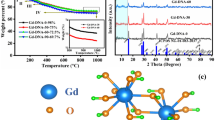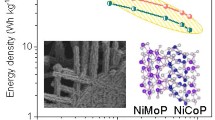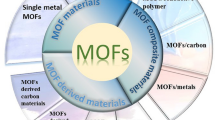Abstract
Polyaniline-derived oxygen- and nitrogen-decorated hierarchical porous carbons (N/O-HPC) are easily prepared by fast electrochemical polymerization combined with pyrolysis process. During the heating process, perchloric acid was decomposed to produce oxygen which could react with PANI-derived carbon to form a porous structure. The XPS results show the content of oxygen and nitrogen functional groups in the porous carbon matrix is 4.31% and 4.42%, respectively, and the BET results show that the specific surface area of the porous carbon is 1197.4 m2 g−1. The high content of oxygen and nitrogen functional groups as well as the high specific surface area is beneficial to N/O-HPC materials as supercapacitors. Typically, N/O-HPC displays a high specific capacitance of 419.8 F g−1, 179.8 F g−1, and 343.2 F g−1 at 0.2 A g−1 in 1 M H2SO4, 0.5 M K2SO4, and 6 M KOH electrolytes, respectively. Specially, the maintenance of capacitance is over 93% after 5000 cycles at 5 A g−1 in all three electrolyte solutions. The outstanding electrochemical performance of N/O-HPC can be ascribed to the introduction of nitrogen and oxygen functional groups in porous carbon matrix and the formation of special porous structure.







Similar content being viewed by others
References
Muzaffar A, Ahamed MB, Deshmukh K, Thirumalai J (2019) A review on recent advances in hybrid supercapacitors: design, fabrication and applications. Renew Sust Energ Rev 101:123–145
Zdolsek N, Rocha RP, Krstic J, Trtic-Petrovic T, Sljukic B, Figueiredo JL, Vujkovic MJ (2019) Electrochemical investigation of ionic liquid-derived porous carbon materials for supercapacitors: pseudocapacitance versus electrical double layer. Electrochim Acta 298:541–551
Conway BE, Pell WG (2003) Double-layer and pseudocapacitance types of electrochemical capacitors and their applications to the development of hybrid devices. J Solid State Electrochem 7(9):637–644
Wang G, Zhang Y, Zhou F, Sun Z, Huang F, Yu Y, Chen L, Pan M (2016) Simple and fast synthesis of polyaniline nanofibers/carbon paper composites as supercapacitor electrodes. J Energy Storage 7:99–103
Lee HW, Shinde NM, Shinde PV, Yun JM, Song PK, Kim KH (2019) High energy and power density of self-grown CuS@Cu2O core-shell supercapattery positrode. J Solid State Electrochem 23(9):2609–2617
Ciszewski M, Koszorek A, Radko T, Szatkowski P, Janas D (2019) Review of the selected carbon-based materials for symmetric supercapacitor application. J Electron Mater 48(2):717–744
Cherusseri J, Kumar KS, Choudhary N, Nagaiah N, Jung Y, Roy T, Thomas J (2019) Novel mesoporous electrode materials for symmetric, asymmetric and hybrid supercapacitors. Nanotechnology 30(20):202001
Ke C-C, Zhang N, Liu F, Yu Q, Wang F-Y, Liu L, Zhang R-L, Liu X, Zeng R-C (2019) Deflated balloon-like nitrogen-rich sulfur-containing hierarchical porous carbons for high-rate supercapacitors. Appl Surf Sci 484:716–725
Sun F, Qu Z, Gao J, Wu HB, Liu F, Han R, Wang L, Pei T, Zhao G, Lu Y (2018) In situ doping boron atoms into porous carbon nanoparticles with increased oxygen graft enhances both affinity and durability toward electrolyte for greatly improved supercapacitive performance. Adv Funct Mater 28(41)
Li J, Li X, Xiong D, Wang L, Li D (2019) Enhanced capacitance of boron-doped graphene aerogels for aqueous symmetric supercapacitors. Appl Surf Sci 475:285–293
Kang W, Lin B, Huang G, Zhang C, Hou W, Yao Y, Xu B, Xing B (2017) Nitrogen and oxygen co-doped porous carbon for high performance supercapacitors. J Mater Sci-Mater Electron 29(4):3340–3347
Deng Y, Xie Y, Zou K, Ji X (2016) Review on recent advances in nitrogen-doped carbons: preparations and applications in supercapacitors. J Mater Chem 4(4):1144–1173
He D, Niu J, Dou M, Ji J, Huang Y, Wang F (2017) Nitrogen and oxygen co-doped carbon networks with a mesopore-dominant hierarchical porosity for high energy and power density supercapacitors. Electrochim Acta 238:310–318
Hulicova-Jurcakova D, Seredych M, Lu GQ, Bandosz TJ (2009) Combined effect of nitrogen- and oxygen-containing functional groups of microporous activated carbon on its electrochemical performance in supercapacitors. Adv Funct Mater 19(3):438–447
He D, Huang Z-H, Wang M-X (2018) Porous nitrogen and oxygen co-doped carbon microtubes derived from plane tree fruit fluff for high-performance supercapacitors. J Mater Sci-Mater Electron 30(2):1468–1479
Jain A, Tripathi SK (2013) Converting eucalyptus leaves into mesoporous carbon for its application in quasi solid-state supercapacitors. J Solid State Electrochem 17(9):2545–2550
Zhang L, Xu L, Zhang Y, Zhou X, Zhang L, Yasin A, Wang L, Zhi K (2018) Facile synthesis of bio-based nitrogen- and oxygen-doped porous carbon derived from cotton for supercapacitors. RSC Adv 8(7):3869–3877
Yuan C, Liu X, Jia M, Luo Z, Yao J (2015) Facile preparation of N- and O-doped hollow carbon spheres derived from poly(o-phenylenediamine) for supercapacitors. J Mater Chem 3(7):3409–3415
Mentus S, Ćirić-Marjanović G, Trchova M, Stejskal J (2009) Conducting carbonized polyaniline nanotubes. Nanotechnology 20(24):245601
Ma G, Yang Q, Sun K, Peng H, Ran F, Zhao X, Lei Z (2015) Nitrogen-doped porous carbon derived from biomass waste for high-performance supercapacitor. Bioresour Technol 197:137–142. https://doi.org/10.1016/j.biortech.2015.07.100
Zuo S, Chen J, Liu W, Li X, Kong Y, Yao C, Fu Y (2018) Preparation of 3D interconnected hierarchical porous N-doped carbon nanotubes. Carbon 129:199–206
Kobayashi H, Sakurai T, Nishiyama M, Nishioka Y (2001) Formation of a SiO2/SiC structure at 203 degrees C by use of perchloric acid. Appl Phys Lett 78(16):2336–2338
Kruk M, Jaroniec M (2001) Gas adsorption characterization of ordered organic-inorganic nanocomposite materials. Chem Mater 13(10):3169–3183
Wang C, Sun L, Zhou Y, Wan P, Zhang X, Qiu J (2013) P/N co-doped microporous carbons from H3PO4-doped polyaniline by in situ activation for supercapacitors. Carbon 59:537–546
Gavrilov N, Pašti IA, Vujković M, Travas-Sejdic J, Ćirić-Marjanović G, Mentus SV (2012) High-performance charge storage by N-containing nanostructured carbon derived from polyaniline. Carbon 50(10):3915–3927
Yan Y, Tang H, Wu F, Wang R, Pan M (2017) One-step self-assembly synthesis α-Fe2O3 with carbon-coated nanoparticles for stabilized and enhanced supercapacitors electrode. Energies 10(9):1296
Cheng M, Meng Y, Meng Q, Mao L, Zhang M, Amin K, Ahmad A, Wu S, Wei Z (2018) A hierarchical porous N-doped carbon electrode with superior rate performance and cycling stability for flexible supercapacitors. Mater Chem Front 2(5):986–992
Serwar M, Rana UA, Siddiqi HM, Khan SU-D, Ali FAA, Al-Fatesh A, Adomkevicius A, Coca-Clemente JA, Cabo-Fernandez L, Braga F, Hardwick LJ (2017) Template-free synthesis of nitrogen doped carbon materials from an organic ionic dye (murexide) for supercapacitor application. RSC Adv 7(86):54626–54637
Panja T, Bhattacharjya D, Yu J-S (2015) Nitrogen and phosphorus co-doped cubic ordered mesoporous carbon as a supercapacitor electrode material with extraordinary cyclic stability. J Mater Chem 3(35):18001–18009
Oh YJ, Yoo JJ, Kim YI, Yoon JK, Yoon HN, Kim J-H, Park SB (2014) Oxygen functional groups and electrochemical capacitive behavior of incompletely reduced graphene oxides as a thin-film electrode of supercapacitor. Electrochim Acta 116:118–128
Yang W, Yang W, Song A, Gao L, Su L, Shao G (2017) Supercapacitance of nitrogen-sulfur-oxygen co-doped 3D hierarchical porous carbon in aqueous and organic electrolyte. J Power Sources 359:556–567
Lufrano F, Staiti P (2010) Influence of the surface—chemistry of modified mesoporous carbon on the electrochemical behavior of solid-state supercapacitors. Energy Fuel 24(6):3313–3320
Sugimoto W, Kizaki T, Yokoshima K, Murakami Y, Takasu Y (2004) Evaluation of the pseudocapacitance in RuO2 with a RuO2/GC thin film electrode. Electrochim Acta 49(2):313–320
Hulicova D, Yamashita J, Soneda Y, Hatori H, Kodama M (2005) Supercapacitors prepared from melamine-based carbon. Chem Mater 17(5):1241–1247
He Q, Liu J, Liu X, Li G, Chen D, Deng P, Liang J (2018) Fabrication of amine-modified magnetite-electrochemically reduced graphene oxide nanocomposite modified glassy carbon electrode for sensitive dopamine determination. Nanomaterials 8(4):194
Yang P, Mai W (2014) Flexible solid-state electrochemical supercapacitors. Nano Energy 8:274–290
Zhang F, Liu T, Li M, Yu M, Luo Y, Tong Y, Li Y (2017) Multiscale pore network boosts capacitance of carbon electrodes for ultrafast charging. Nano Lett 17(5):3097–3104
Zhou X, Wang P, Zhang Y, Wang L, Zhang L, Zhang L, Xu L, Liu L (2017) Biomass based nitrogen-doped structure-tunable versatile porous carbon materials. J Mater Chem 5(25):12958–12968
Zhang JJ, Fan HX, Dai XH, Yuan SJ (2018) Digested sludge-derived three-dimensional hierarchical porous carbon for high-performance supercapacitor electrode. R Soc Open Sci 5(4):172456
Shi Q, Zhang R, Lv Y, Deng Y, Elzatahrya AA, Zhao D (2015) Nitrogen-doped ordered mesoporous carbons based on cyanamide as the dopant for supercapacitor. Carbon 84:335–346
Liu X, Liu X, Sun B, Zhou H, Fu A, Wang Y, Guo Y-G, Guo P, Li H (2018) Carbon materials with hierarchical porosity: effect of template removal strategy and study on their electrochemical properties. Carbon 130:680–691
Li X, Zhao Y, Bai Y, Zhao X, Wang R, Huang Y, Liang Q, Huang Z (2017) A non-woven network of porous nitrogen-doping carbon nanofibers as a binder-free electrode for supercapacitors. Electrochim Acta 230:445–453
Zhou J, Xu L, Li L, Li X (2019) Polytetrafluoroethylene-assisted N/F co-doped hierarchically porous carbon as a high performance electrode for supercapacitors. J Colloid Interface Sci 545:25–34
Wang S, Ren Z, Li J, Ren Y, Zhao L, Yu J (2014) Cotton-based hollow carbon fibers with high specific surface area prepared by ammonia etching for supercapacitor application. RSC Adv 4(59):31300–31307
Funding
This work was support by the National Key Research and Development Program of China (No. 2016YFB0101300 (2016YFB0101313)) and the Fundamental Research Funds for the Central Universities (WUT: 182443002).
Author information
Authors and Affiliations
Corresponding authors
Additional information
Publisher’s note
Springer Nature remains neutral with regard to jurisdictional claims in published maps and institutional affiliations.
Rights and permissions
About this article
Cite this article
Zhou, F., Guan, S., Yan, Y. et al. Polyaniline-derived nitrogen- and oxygen-decorated hierarchical porous carbons as an efficient electrode material for supercapacitors. J Solid State Electrochem 24, 951–959 (2020). https://doi.org/10.1007/s10008-020-04545-x
Received:
Revised:
Accepted:
Published:
Issue Date:
DOI: https://doi.org/10.1007/s10008-020-04545-x




